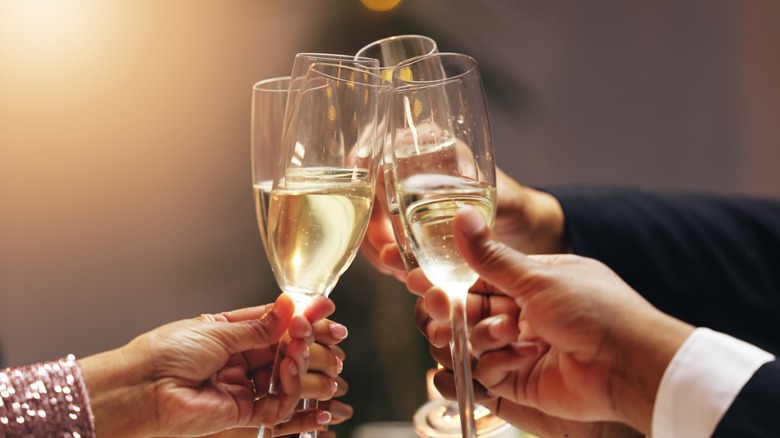What Is Champagne Actually Made Of And How Does It Differ From Regular Wine?
There are some facets to the wine world that might feel like splitting corks, but at the end of the day, those distinctions are what make the drink such an immersive and elaborate experience. And, not to play the "um, actually" card, but Champagne has to come from a specific region and has its own set of production rules and label distinctions. These rules are what set it apart from still wines and other effervescent aspirants. First and foremost, Champagne can only come from the Champagne region of France.
This region, located a couple hours northeast of Paris, has been making different wines for millennia, and the exclusive production style created here is where the rules for Champagne-making originate. When looking at the labels for Champagne, you'll notice that most of the information follows the same outline as still wines: producer, vintage, and grape varietal. What is more frequent with Champagne, and eventually other sparkling wines, though, is the residual sugar statement and the village ratings like Premier Cru or Grand Cru — vintners who've demonstrated routinely exceptional wines.
When it comes to determining the sweetness levels of Champagne and sparkling wine, the scale shifts from that used for still wines. With still wines like sauvignon blanc, merlot, or pinot gris, the word "dry" means it will be less sweet. However, with Champagne (and by proxy all sparkling wine) the word "dry" will denote a wine that will have more residual sugars and taste sweeter. The scale will move from less sweet/minimal sugar occurring naturally to sweeter/additional sugars added or naturally occurring. Common verbiage along the scale will be extra brut, brut, extra dry, dry, and demi-sec.
It all comes down to grapes, fermentation, and rest time
There are three main types of grapes that go into Champagne: Pinot Noir, Pinot Meunier, and Chardonnay. Of these grapes, two are traditionally used for red wines outside of Champagne-making and one is predominately used for white wine. Most Champagne (and other sparkling wines made in the Champagne style) will feature all three. Where this differs is in the blanc de blanc and blanc de noir styles. Depending on how well up you are on your French, "blanc de blanc," or "white from white," uses only the white grapes like Chardonnay. "Blanc de noir," or "white from black," will use — you guessed it — dark grapes like Pinot Noir and Pinot Meunier. Some Champagne houses might add in other grape varietals to the overall blending process, but those instances are few and far between.
The magic of Champagne rests in the lengthy two-step fermentation process. Each grape varietal goes through the initial fermentation process individually, like a rough draft in fermentation. After this step, the segregated varietals are then blended together. The actual blend build will vary from maison to maison (French for "house") to create each's signature taste profile. The aim with these first steps is to maintain a consistent flavor build that's specific to, say, Veuve Clicquot or Piper Heidsieck or Moët Chandon year after year. Vintners in these larger maisons want the bottle you bought two years ago to taste the same as the bottle you will buy next month.
After blending, the aging process continues to set Champagne apart, not just from still wines but from other sparkling wines as well. This aspect of the "méthod Champenoise" is what gives Champagne its unique bubbles. Unlike with Cava or Prosecco, this inclusion of carbon dioxide occurs inside the bottles while they rest on their sides. As the yeast involved in the fermentation process eat up the sugars in the wine, carbon dioxide is released, which is then trapped in the bottles. The carbonation method involved with Champagne through the lengthy resting periods — anywhere from 15 to 36 months prior to removing the yeast waste and then longer depending on house, known as aging on lees — is what gives the wine its signature pastry, bread-like, and creamy taste.
Popping Champagne versus other sparkling wines
So, to briefly recap, Champagne can only come from the Champagne region of France, it has to be made in the traditional "méthod Champenoise" featuring the multistep, multiyear fermentation and aging process all inside the bottle, will feature at minimum Pinot Noir, Pinot Meunier, and Chardonnay grapes, and one more time for those in back, comes only from Champagne, France. Because many sparkling wine brands follow the same production process as Champagne, phrases like "Champagne style sparkling wine" will appear on some labels or "méthode traditionnelle" on others. Basically, trying to prove that it is as close to Champagne as it can get without being made in Champagne.
For those trying to be Jay Gatsby on a budget, there are a few tricks to picking great Champagne without breaking the bank. There's never a wrong time to pop open a bottle of bubbles — graduation, promotion, New Year's, a Tuesday. Not to sound too much like a purist as quality Champagne is perfect to sip on its own, but, Kir Royale cocktails are another delicious way to elevate an already great glass of bubbly. Other sparkling wines and Prosecco are fantastic for beverages like mimosas or bellinis. For an amazing food pairing, enjoy a glass of Champagne with anything fried like crispy rye and cornmeal fried green tomatoes or with a greasy slice of pepperoni pizza. The combination of bubbles, high acidity, grease, and yeast is phenomenal. Happy drinking!



